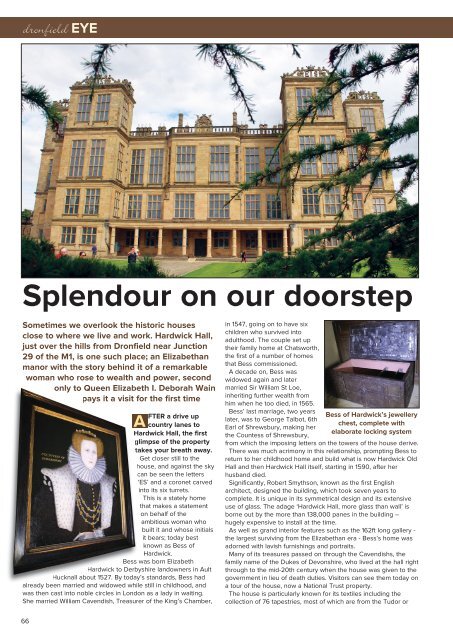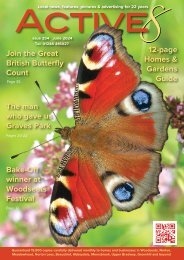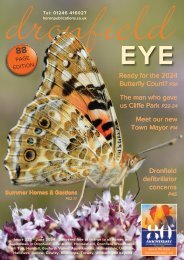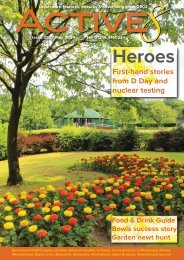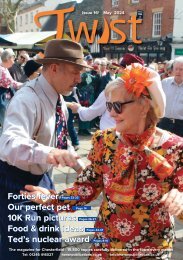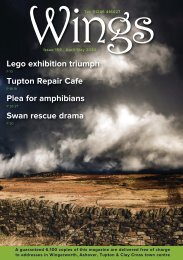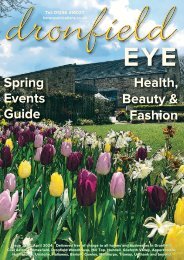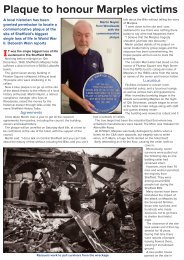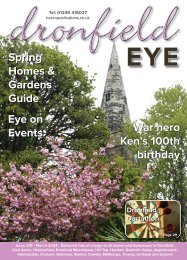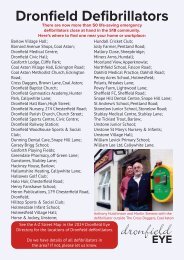Dronfield Eye Issue 213 September 2023
You also want an ePaper? Increase the reach of your titles
YUMPU automatically turns print PDFs into web optimized ePapers that Google loves.
dronfield EYE<br />
Splendour on our doorstep<br />
Sometimes we overlook the historic houses<br />
close to where we live and work. Hardwick Hall,<br />
just over the hills from <strong>Dronfield</strong> near Junction<br />
29 of the M1, is one such place; an Elizabethan<br />
manor with the story behind it of a remarkable<br />
woman who rose to wealth and power, second<br />
only to Queen Elizabeth I. Deborah Wain<br />
pays it a visit for the first time<br />
A<br />
FTER a drive up<br />
country lanes to<br />
Hardwick Hall, the first<br />
glimpse of the property<br />
takes your breath away.<br />
Get closer still to the<br />
house, and against the sky<br />
can be seen the letters<br />
‘ES’ and a coronet carved<br />
into its six turrets.<br />
This is a stately home<br />
that makes a statement<br />
on behalf of the<br />
ambitious woman who<br />
built it and whose initials<br />
it bears; today best<br />
known as Bess of<br />
Hardwick.<br />
Bess was born Elizabeth<br />
Hardwick to Derbyshire landowners in Ault<br />
Hucknall about 1527. By today’s standards, Bess had<br />
already been married and widowed while still in childhood, and<br />
was then cast into noble circles in London as a lady in waiting.<br />
She married William Cavendish, Treasurer of the King’s Chamber,<br />
in 1547, going on to have six<br />
children who survived into<br />
adulthood. The couple set up<br />
their family home at Chatsworth,<br />
the first of a number of homes<br />
that Bess commissioned.<br />
A decade on, Bess was<br />
widowed again and later<br />
married Sir William St Loe,<br />
inheriting further wealth from<br />
him when he too died, in 1565.<br />
Bess’ last marriage, two years<br />
later, was to George Talbot, 6th<br />
Earl of Shrewsbury, making her<br />
the Countess of Shrewsbury,<br />
Bess of Hardwick’s jewellery<br />
chest, complete with<br />
elaborate locking system<br />
from which the imposing letters on the towers of the house derive.<br />
There was much acrimony in this relationship, prompting Bess to<br />
return to her childhood home and build what is now Hardwick Old<br />
Hall and then Hardwick Hall itself, starting in 1590, after her<br />
husband died.<br />
Significantly, Robert Smythson, known as the first English<br />
architect, designed the building, which took seven years to<br />
complete. It is unique in its symmetrical design and its extensive<br />
use of glass. The adage ‘Hardwick Hall, more glass than wall’ is<br />
borne out by the more than 138,000 panes in the building –<br />
hugely expensive to install at the time.<br />
As well as grand interior features such as the 162ft long gallery -<br />
the largest surviving from the Elizabethan era - Bess’s home was<br />
adorned with lavish furnishings and portraits.<br />
Many of its treasures passed on through the Cavendishs, the<br />
family name of the Dukes of Devonshire, who lived at the hall right<br />
through to the mid-20th century when the house was given to the<br />
government in lieu of death duties. Visitors can see them today on<br />
a tour of the house, now a National Trust property.<br />
The house is particularly known for its textiles including the<br />
collection of 76 tapestries, most of which are from the Tudor or<br />
66


